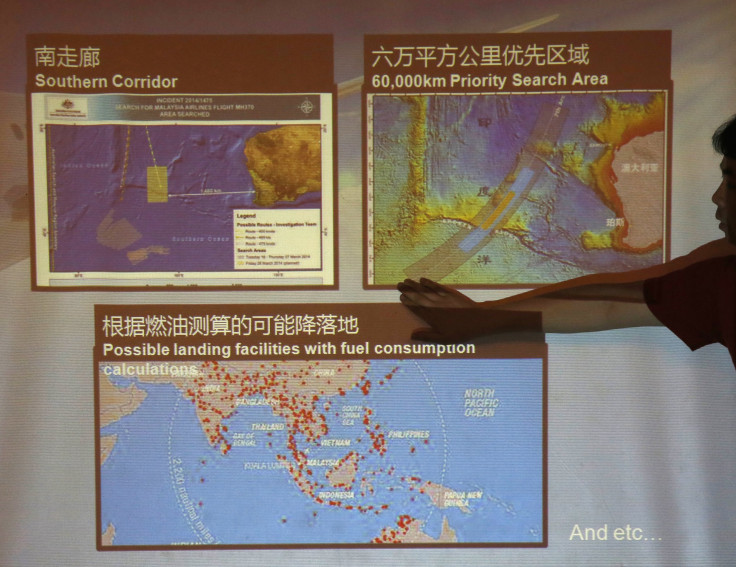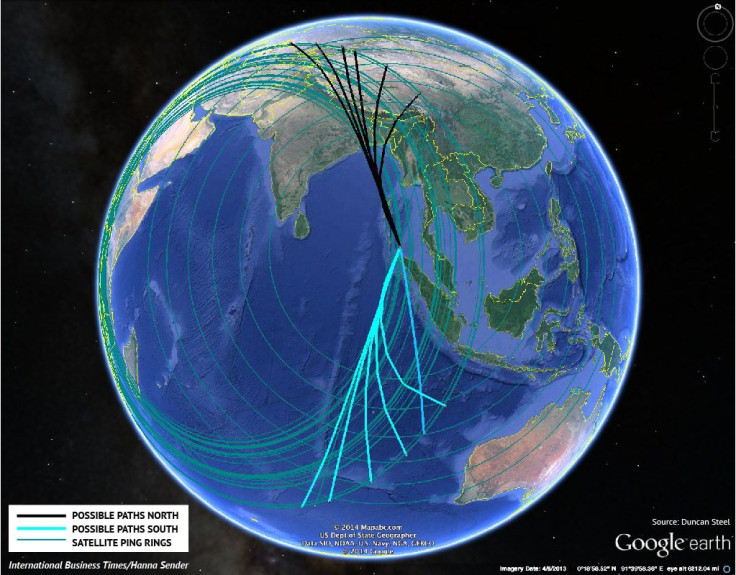MH370 Route On Map: Where Malaysia Airlines Flight Was Headed And Where It Ended Up Going

The disappearance of Malaysia Airlines Flight MH370 on March 8 last year is an enigma that has yet to be solved as the plane remains elusive to searchers one year after its disappearance. Groups seeking the missing are still on a frantic chase for clues as efforts moved from the South China Sea to the Andaman Sea, with the plane eventually presumed to have crashed in the South India Sea as more data from satellites and radar were revealed.
The below map of the presumed route the doomed plane took after taking off from Malaysia was drawn from data provided by the Independent Group, which is comprised of 18 people who used information and public data from civil aviation authorities to formulate the plane's path. The route map coincides with areas of government's search efforts and represents the most likely route taken by the plane as well as its final resting place.
The flight departed at 12.41 a.m. local time from Kuala Lumpur carrying 239 people on board including passenger and crew and was en route to Beijing before it lost contact with air traffic control at 1.19 a.m. Search teams were puzzled where the plane could have been, initially casting their sights in the South China Sea, but it was later revealed by Malaysia that military ground radars detected the plane at 2.15 a.m. flying west of the peninsula and then slightly north over the Andaman Sea, before losing contact.
That last known point gave searchers a clue where the plane could be headed. The Boeing 777-200ER jetliner had enough fuel to remain flying for seven hours, which could have placed it anywhere as far south as off the coast of Australia, as far west as Somalia or even all the way north to Russia if the plane stayed in a straight line.
A satellite positioned above the Indian Ocean detected pings from the plane at 2.28 a.m. and continued to receive six more approximately once every hour until 8.19 a.m. These pings from the plane, disclosed a week after the plane’s disappearance, helped searchers determine that from its last known location according to Malaysia’s ground radar, it could have either gone north between Thailand and Kazakhstan, or south between Indonesia and the southern Indian Ocean.

Malaysia’s civil aviation authority was originally tight-lipped about its satellite data, but eventually released it 80 days after the plane went missing. British satellite telecommunications company Inmarsat was able to use that data to determine that the plane headed south, according to the Guardian. Inmarsat's interpretation of the data has been verified by an international investigation team from Malaysia, the United States, Britain and China.
"It is highly, highly likely that the aircraft was on autopilot otherwise it could not have followed the orderly path that has been identified through the satellite sightings," Australia’s Deputy Prime Minister Warren Truss said, according to BBC. Australian searchers had a false alarm when search efforts detected what they thought to be several acoustic pings from the plane’s flight data recorders, also known as “black boxes.” Officials eventually said that they were not from the plane.
Search efforts in the South Indian Ocean led by Australia have been focused in the arc suggested by the plane’s final ping with the satellite, some 1,100 miles off the west coast of Perth. That area covers some 60,000 square kilometers (23,200 square miles), according to the BBC. Nearly a year since the search started, Australian Prime Minister Tony Abbott said Thursday that efforts might be scaled back because the search has been unfruitful. How long the search was going to continue was up to the Australian and Malaysian governments, according to Agence France-Presse.
Malaysia has declared MH370 to be an accident, and has presumed all on board to be dead. The government has given Malaysia Airlines the clearing to compensate relatives of the victims, but most of the families said they have not received the full amount they were entitled to. Many have also refused to accept Malaysia’s official statement, clinging on to the hope that their loved ones who boarded the plane might still be alive.
© Copyright IBTimes 2025. All rights reserved.






















